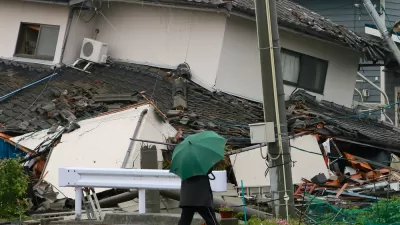Edwin Heathcote examines the common ethos that connects Kyoto's Katsura Imperial Villa and Los Angeles's Schindler House, "two homes, far apart in time and space, that influenced the modern movement."
Heathcote draws a line from Japan's traditional architecture, where "[w]alls are ephemeral – paper framed in slender wooden battens – and can be slid aside to disappear entirely and open up the rooms to the landscape or allow spaces to flow into each other," through Bruno Taut, Walter Gropius, Le Corbusier, and Austrian emigre Rudolf Schindler who were highly influenced by the conceptions of space, materiality, and history found in buildings like the Katsura Imperial Villa. "Coming from cities hidebound in history where architects were constrained by respect for the existing fabric and forced to build in streets laid out of medieval palimpsests," says Heathcote, "they were profoundly impressed by this building existing in a landscape and generated by its own internal geometry."
Of Schindler's house on Kings Road in West Hollywood, which Heathcote calls "arguably the first modernist house in the US," he says "[i]t is profoundly Japanese in character: dark timber posts and beams filled in with white panels recall the paper walls of the Katsura Villa."
"Like the Japanese model, the walls were sliding and spaces flowed into each other. There were no corridors and there was no fixed hierarchy of rooms; this was a house with a fluid plan that presaged the modernism of Mies van der Rohe while also looking back to Frank Lloyd Wright’s wonderfully expansive plans."
"Wright himself was hugely influenced by what he saw in Japan but Schindler managed to imbibe more than style or impression, he translated the deceptively simple complexity of Japanese architecture into an American model."
FULL STORY: Proportional perfection

Alabama: Trump Terminates Settlements for Black Communities Harmed By Raw Sewage
Trump deemed the landmark civil rights agreement “illegal DEI and environmental justice policy.”

Planetizen Federal Action Tracker
A weekly monitor of how Trump’s orders and actions are impacting planners and planning in America.

Why Should We Subsidize Public Transportation?
Many public transit agencies face financial stress due to rising costs, declining fare revenue, and declining subsidies. Transit advocates must provide a strong business case for increasing public transit funding.

Understanding Road Diets
An explainer from Momentum highlights the advantages of reducing vehicle lanes in favor of more bike, transit, and pedestrian infrastructure.

New California Law Regulates Warehouse Pollution
A new law tightens building and emissions regulations for large distribution warehouses to mitigate air pollution and traffic in surrounding communities.

Phoenix Announces Opening Date for Light Rail Extension
The South Central extension will connect South Phoenix to downtown and other major hubs starting on June 7.
Urban Design for Planners 1: Software Tools
This six-course series explores essential urban design concepts using open source software and equips planners with the tools they need to participate fully in the urban design process.
Planning for Universal Design
Learn the tools for implementing Universal Design in planning regulations.
Caltrans
Smith Gee Studio
Institute for Housing and Urban Development Studies (IHS)
City of Grandview
Harvard GSD Executive Education
Toledo-Lucas County Plan Commissions
Salt Lake City
NYU Wagner Graduate School of Public Service



























